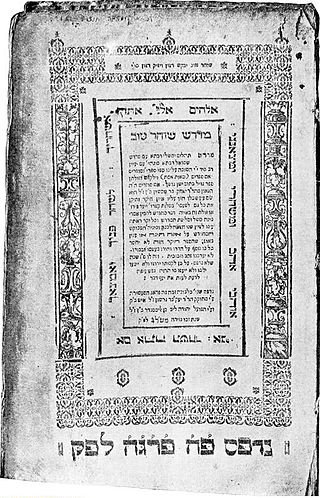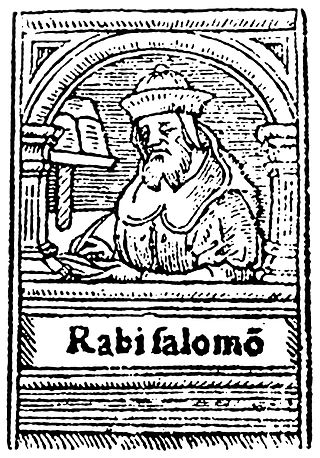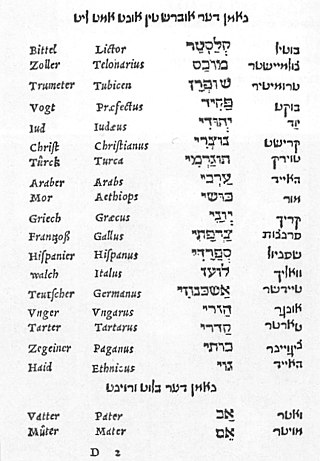
The Mishnah or the Mishna is the first written collection of the Jewish oral traditions that are known as the Oral Torah. It is also the first work of rabbinic literature, with the oldest surviving material dating to the 6th to 7th centuries CE.

Midrash is expansive Jewish Biblical exegesis using a rabbinic mode of interpretation prominent in the Talmud. The word itself means "textual interpretation", "study", or "exegesis", derived from the root verb darash (דָּרַשׁ), which means "resort to, seek, seek with care, enquire, require".

Shlomo Yitzchaki, commonly known by the acronym Rashi, was a French rabbi who authored comprehensive commentaries on the Talmud and Hebrew Bible.

The Torah is the compilation of the first five books of the Hebrew Bible, namely the books of Genesis, Exodus, Leviticus, Numbers and Deuteronomy. The Torah is also known as the Pentateuch or the Five Books of Moses. In Rabbinical Jewish tradition it is also known as the Written Torah. If meant for liturgic purposes, it takes the form of a Torah scroll. If in bound book form, it is called Chumash, and is usually printed with the rabbinic commentaries.

Rabbinic literature, in its broadest sense, is the entire corpus of works authored by rabbis throughout Jewish history. The term typically refers to literature from the Talmudic era, as opposed to medieval and modern rabbinic writings. It aligns with the Hebrew term Sifrut Chazal, which translates to “literature [of our] sages” and generally pertains only to the sages (Chazal) from the Talmudic period. This more specific sense of "Rabbinic literature"—referring to the Talmud, Midrashim, and related writings, but hardly ever to later texts—is how the term is generally intended when used in contemporary academic writing. The terms mefareshim and parshanim almost always refer to later, post-Talmudic writers of rabbinic glosses on Biblical and Talmudic texts.
ArtScroll is an imprint of translations, books and commentaries from an Orthodox Jewish perspective published by Mesorah Publications, Ltd., a publishing company based in Rahway, New Jersey. Rabbi Nosson Scherman is the general editor.
The Ketuvim is the third and final section of the Hebrew Bible, after the Torah ("instruction") and the Nevi'im "Prophets". In English translations of the Hebrew Bible, this section is usually titled "Writings" or "Hagiographa".

Exegesis is a critical explanation or interpretation of a text. The term is traditionally applied to the interpretation of Biblical works. In modern usage, exegesis can involve critical interpretations of virtually any text, including not just religious texts but also philosophy, literature, or virtually any other genre of writing. The phrase Biblical exegesis can be used to distinguish studies of the Bible from other critical textual explanations.

Tkhines or teḥinot may refer to Yiddish prayers and devotions, usually personal and from a female viewpoint, or collections of such prayers. They were written for Ashkenazi Jewish women who, unlike the men of the time, typically could not read Hebrew, the language of the established synagogue prayer book. They were most popular from the 1600s to the early 1800s, with the first major collection of tkhines, the Seyder Tkhines, being printed in 1648. Unlike Hebrew prayers, tkhines dealt with issues specific to women. Despite being for women, it is thought that many tkhines were written by men and the authorship of most tkhines is often difficult to establish, due to multiple publications of the same tkhine and the use of pseudonyms.

Chumash is a Torah in printed in book bound form as opposed to a Torah scroll.

Bahya ben Asher ibn Halawa was a rabbi and scholar of Judaism, best known as a commentator on the Hebrew Bible. He is one of two scholars now referred to as Rabbeinu Behaye, the other being philosopher Bahya ibn Paquda.

A Mikraot Gedolot, often called a "Rabbinic Bible" in English, is an edition of the Hebrew Bible that generally includes three distinct elements:
Hebrew Bible English translations are English translations of the Hebrew Bible (Tanakh) according to the Masoretic Text, in the traditional division and order of Torah, Nevi'im, and Ketuvim. Most Jewish translations appear in bilingual editions (Hebrew–English).
Soncino Press is a Jewish publishing company based in the United Kingdom that has published a variety of books of Jewish interest, most notably English translations and commentaries to the Talmud and Hebrew Bible. The Soncino Hebrew Bible and Talmud translations and commentaries were widely used in both Orthodox and Conservative synagogues until the advent of other translations beginning in the 1990s.
Jewish commentaries on the Bible are biblical commentaries of the Hebrew Bible from a Jewish perspective. Translations into Aramaic and English, and some universally accepted Jewish commentaries with notes on their method of approach and also some modern translations into English with notes are listed.

The Yalkut Shimoni, or simply Yalkut, is an aggadic compilation on the books of the Hebrew Bible. It is a compilation of older interpretations and explanations of Biblical passages, arranged according to the sequence of those portions of the Bible to which they referred.
Shnayim mikra ve-echad targum, is the Jewish practice of reading the weekly Torah portion in a prescribed manner. In addition to hearing the Torah portion read in the synagogue, a person should read it himself twice during that week, together with a translation usually by Targum Onkelos and/or Rashi's commentary. In addition, while not required by law, there exists an Ashkenazi custom to also read the portion from the Prophets with its targum.

In the early part of the sixteenth century, there were already attempts to translate the Bible into Yiddish, including Hebrew-Yiddish biblical dictionaries. One of the most authoritative was the Bible that Jekuthiel Blitz translated in 1678.

Vaybertaytsh or mashket, is a semi-cursive script typeface for the Yiddish alphabet. From the 16th until the early 19th century, the mashket font distinguished Yiddish publications, whereas Hebrew square script were used for classical texts in Hebrew and Aramaic, and "Rashi" script for rabbinic commentaries and works in Ladino.
Aaron ben Samuel of Hergershausen was a Hessian Jewish writer. He is considered to be the first person in Germany to attempt to bring about the use of the vernacular in lieu of the Hebrew in the daily prayers.











